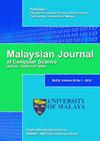一种以成对方式合并一组模型的方法和工具
IF 1.2
4区 计算机科学
Q4 COMPUTER SCIENCE, ARTIFICIAL INTELLIGENCE
引用次数: 0
摘要
模型合并解决了将一组模型中的信息合并为单个模型的问题。这项任务被认为是各种软件工程实践中的重要一步。当需要合并许多(两个以上)模型时,最常用的技术是以成对的方式执行合并,而不考虑合并的顺序。这种技术的问题是,由于受到这种顺序的影响,因此无法保证结果的质量。在本文中,我们提出了一种成对的模型合并方法,旨在通过考虑合并的顺序来提供更好的结果。这种方法建议在迭代过程中组合模型,直到只获得一个模型。在每次迭代中,我们首先比较每对模型,以测量它们之间的相似性,并识别它们的组成元素之间的对应关系。这是使用两个分别命名为compare和match的基于启发式的运算符来执行的。之后,我们确定最相似的模型对,并使用所提出的运算符将它们合并。我们已经将我们的方法作为3M工具支持进行了实施,并在一组案例研究中对其进行了评估。本文章由计算机程序翻译,如有差异,请以英文原文为准。
AN APPROACH AND A TOOL FOR MERGING A SET OF MODELS IN PAIRWISE WAY
Model merging addresses the problem of combining information from a set of models into a single one. This task is considered to be an important step in various software engineering practices. When many (more than two) models need to be merged, the most practiced technique is to perform the merge in a pairwise way, without considering the order of merging. The problem with this technique is that the resulting quality is not guaranteed because it is influenced by such an order. In this paper, we propose a pairwise approach for model merging aiming to provide better results by taking into account the order of merging. This approach proposes to combine models in an iterative process until obtaining only one model. At each iteration, we first compare each pair of models in order to measure the similarity between them and to identify the correspondences between their component elements. This is performed using two heuristic-based operators respectively named compare and match. After that, we identify the most similar pairs of models and merge them using a proposed operator. We have implemented our approach as tool support called 3M and evaluated it on a set of case studies.
求助全文
通过发布文献求助,成功后即可免费获取论文全文。
去求助
来源期刊

Malaysian Journal of Computer Science
COMPUTER SCIENCE, ARTIFICIAL INTELLIGENCE-COMPUTER SCIENCE, THEORY & METHODS
CiteScore
2.20
自引率
33.30%
发文量
35
审稿时长
7.5 months
期刊介绍:
The Malaysian Journal of Computer Science (ISSN 0127-9084) is published four times a year in January, April, July and October by the Faculty of Computer Science and Information Technology, University of Malaya, since 1985. Over the years, the journal has gained popularity and the number of paper submissions has increased steadily. The rigorous reviews from the referees have helped in ensuring that the high standard of the journal is maintained. The objectives are to promote exchange of information and knowledge in research work, new inventions/developments of Computer Science and on the use of Information Technology towards the structuring of an information-rich society and to assist the academic staff from local and foreign universities, business and industrial sectors, government departments and academic institutions on publishing research results and studies in Computer Science and Information Technology through a scholarly publication. The journal is being indexed and abstracted by Clarivate Analytics'' Web of Science and Elsevier''s Scopus
 求助内容:
求助内容: 应助结果提醒方式:
应助结果提醒方式:


